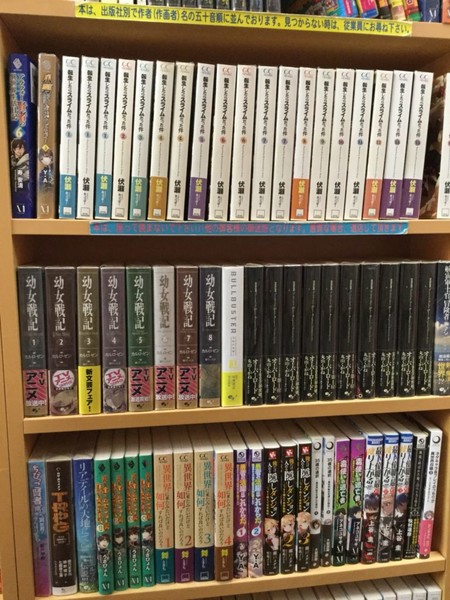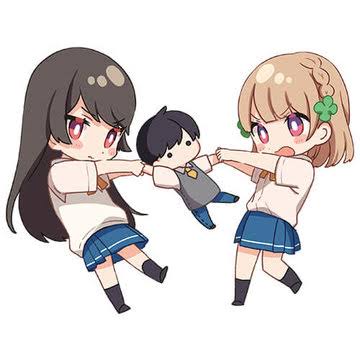The Light Novels of 2019 Went Back to School
by Kim Morrissy,Could the isekai boom finally be receding? That might seem hard to imagine right now given that it feels like there's half a dozen isekai anime per season, but when you look closer at the market trends from this year, the fantasy subgenre's overwhelming monopoly doesn't seem like such a sure-fire thing. To put it simply, the best-selling new light novels this year have been high school romantic comedies.

Before I go into detail about those fresh new light novels, let me talk about some of the overlooked factors that led to isekai becoming such a big thing in the first place. Light novels in Japan are generally published in either bunkobon (smaller A6-sized books) or tankōbon (larger B6-sized books) size. Tankōbon books typically cost twice as much as bunkobon books, which make them more popular among adults with more disposable income than children. Furthermore, because of their price, tankōbon books enjoy greater profit margins despite selling less copies.
Now, as you may already know, most modern isekai novels originate from amateur web fiction, and their light novel counterparts are compiled and edited versions of stories that are already available to read for free. Some web novel authors in the early days, like Sword Art Online's Reki Kawahara and The Irregular at Magic High School's Tsutomu Satou, removed the web versions when they got a publishing deal, but most authors these days leave their web novels up, because it's the fans of the web novel who go out and buy the book version. This is one of the reasons why they are typically published as tankōbon books - because they are conceived as collector's items.

Tankōbon books are made to look nice on a shelf. Image via Mangasouko
Pushing web novels into tankōbon books has certainly expanded the audience of light novel readers beyond the traditional teen market, but it also means that the market is now fragmented. Readers of isekai web novels aren't necessarily reading bunkobon light novels and vice versa. You can see this divide in the yearly Kono Light Novel ga Sugoi! (This Light Novel Is Amazing!) rankings: Tankōbon books are put into a separate category, and they tend to attract less votes than bunkobon books in general when you look at the cumulative rankings.
When you put tankōbon books aside and focus on what new bunkobon books are selling, completely different market trends start to emerge. Some of the biggest sellers of the past few years have been Rascal Does Not Dream of Bunny Girl Senpai, Classroom of the Elite, and Saekano: How to Raise a Boring Girlfriend. And two of the best-selling new light novels this year are Tomodachi no Imōto ga Ore ni Dake Uzai (My friend's sister is only annoying to me) and Osananajimi ga Zettai ni Makenai Love Comedy (A romantic comedy where the childhood friend definitely does not lose), both of which already have over 100,000 copies in print, according to their publishers. Tomodachi no Imōto ga Ore ni Dake Uzai already has a drama CD in the works, too! It's pretty much guaranteed to get an anime at this rate.
This is without even mentioning the best-selling and most influential high school light novel series of this decade: My Youth Romantic Comedy is Wrong, as I Expected (otherwise known as Oregairu), which announced that it had 10 million copies in circulation not long after its 14th and final volume got published in November. When Oregairu went on semi-hiatus after the second season of the anime aired in 2015, publishers rushed to fill the Hachiman-shaped void in readers' hearts, resulting in titles like Rascal Does Not Dream of Bunny Girl Senpai and Bottom-Tier Character Tomozaki (which is also getting an anime) rising to prominence. Oregairu itself hasn't faded from the picture yet: its third season is coming out in spring.

Oregairu's influence on the light novels of 2019 goes deeper than just "snarky protagonist in a high school setting." Oregairu proved that nobody really wants a bland, self-insert protagonist in their light novels. The point-of-view character has got to have something compelling about him, whether it's a pronounced personality quirk (taken to the extreme with A Sister's All You Need's Itsuki) or outright lying about their motivations to the reader (like Classroom of the Elite's Ayanokoji). Of course, there's been a fair share of light novels featuring Hachiman copycats, but it's no coincidence that the most successful romcoms in the wake of Oregairu play with literary techniques like the unreliable narrator or have protagonists with strong personalities in their own right. The age of Boku wa Tomodachi ga Sukunai and Infinite Stratos is officially over.
Another trend worth pointing out is the evolving depictions of high school, as characters juggle school with a very different kind of real-life occupation. The Ryuo's Work is Never Done!, for instance, has characters in high school, but the story itself focuses entirely on competitive shogi. The same thing goes with things like Eromanga Sensei and 14-sai to Illustrator (14-years old and an illustrator), which have a sub-theme of creating art or manga. Other light novels focus on the adult's point of view, like Oshiego ni Kyōhaku Sareru no ga Hanzai Desu ka? (Is it a crime if you're threatened by your student?) and Hige wo Soru. Soshite Joshi Kōsei wo Hirō (I shave my beard, then pick up a high school girl), where the adult is in charge of taking care of a high school student. Then there are stories like Boku-tachi no Remake (Remake Our Life!), which are about adults going back in time to relive their school lives. Integrating adult perspectives about work and responsibility into stories about high school or early college points to the aging demographics of light novel readers.

Very recently, there's also been a mini-boom of yuri (girls' love) stories, to the extent that this year's Kono Light Novel ga Sugoi! guidebook highlighted it. This has been spurred by a few things: the science fiction yuri boom happening at the sci-fi publisher Hayakawa Shobo in the wake of the award-winning Last and First Idol (which got an English release in 2018); the recent popularity of yuri manga, especially Bloom Into You; and the LGBT boom happening in Japan in general in the last few years. A handful of light novels deal explicitly with social issues and gender roles, like Skirt no Naka no Himitsu, which has a crossdresser and a trans girl as its protagonists, and Sexiled, which is inspired by the Tokyo Medical University sexism scandal. With the yuri light novel Adachi and Shimamura getting an anime, expect to see this corner of the market grow in the future.
Having said all of this, don't expect fantasy stories to lose their prominence. The current output of English light novel publishers is overwhelmingly skewed towards fantasy - much more so than the Japanese market. It was explicitly The Rising of the Shield Hero's popularity with the overseas audience and Crunchyroll's involvement that made producers interested in adapting it to anime. Goblin Slayer is another example of a light novel anime that performed far better with western audiences compared to Japanese ones. You can put a fair amount of this down to cultural differences and the fact that fantasy stories tend to have a broader appeal than stories set in contemporary Japan. With the western anime streaming markets becoming more and more important every year while being more reliable than the lucrative yet fickle Chinese market, we'll probably be seeing more fantasy light novels get greenlit for anime with a western audience in mind.
As light novel properties have exploded in popularity around the world over this past decade, the biggest and most observable trend is the rise of isekai and stories about virtual worlds. It's therefore fitting that Sword Art Online is Kono Light Novel ga Sugoi!'s light novel of the decade. As Reki Kawahara commented, it's representative of the transition period for light novels as they get more and more "online." Nobody can say at the moment where light novels are headed in the next decade, but for the near future, at least, don't discount high school stories entirely. In Japan right now, the scales are tipping towards romcoms. Boku-tachi no Remake announced an anime adaptation in December, and I'm sure that in the next few years even more romcom titles will be adapted into anime. Perhaps some of them will take you by surprise.

discuss this in the forum (25 posts) |